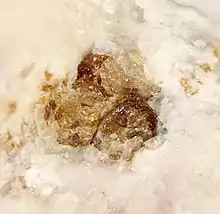Golyshevite
Golyshevite is a rare mineral of the eudialyte group,[2] with the formula Na10Ca3Ca6Zr3Fe2SiNb(Si3O9)2(Si9O27)2CO3(OH)3•H2O.[3] The original formula was extended to show both the presence of cyclic silicate groups and silicon at the M4 site, according to the nomenclature of the eudialyte group.[4] The characteristic feature of golyshevite is calcium-rich composition, with calcium at two main sites instead of one site.[3] Together with feklichevite, fengchengite, ikranite and mogovidite it is a ferric-iron-dominant representative of the group.[2] It is chemically similar to mogovidite.[2][3] Golyshevite was named after Russian crystallographer Vladimir Mikhailovich Golyshev.[3]
| Golyshevite | |
|---|---|
 Golyshevite crystals in matrix, some of them showing a pseudohexagonal section, with the typical yellowish-brown zircon-like colour. Locality: Kovdor Phlogopite Mine, Kovdor Massif, Northern Region, Russian Federation
Size: 2.3 × 2.1 × 1.5 cm | |
| General | |
| Category | Silicate mineral, Cyclosilicate |
| Formula (repeating unit) | (Na,Ca)10Ca9(Fe3+,Fe2+)2Zr3NbSi25O72(CO3)(OH)3·H2O (original form) |
| IMA symbol | Gsv[1] |
| Strunz classification | 9.CO.10 |
| Dana classification | 64.1.6 |
| Crystal system | Trigonal |
| Crystal class | Ditrigonal pyramidal (3m) (same H-M symbol) |
| Space group | R3m |
| Unit cell | a = 14.23 c = 29.98 [Å] (approximated); Z = 3 |
| Identification | |
| Color | Brown to reddish-brown |
| Crystal habit | grains and crystals |
| Cleavage | No |
| Tenacity | Brittle |
| Specific gravity | 2.89 (measured) |
| Optical properties | Uniaxial (-) |
| Refractive index | nω 1.62, nε=1.61 (approximated) |
| Pleochroism | green to pale yellow |
| References | [2][3] |
Occurrence and association
Golyshevite and mogovidite were found in calcium-bearing peralkaline pegmatites of the Kovdor massif, Kola Peninsula, Russia. Minerals associated with golyshevite are aegirine-augite, calcite, cancrinite, hedenbergite, orthoclase, pectolite, tacharanite, and thomsonite-Ca.[3]
Notes on chemistry
Impurities in golyshevite include chlorine, potassium, manganese, aluminium, cerium and lanthanum.[3]
Notes on crystal structure
Calcium in golyshevite is present at M(1) and N(4) sites.[3]
References
- Warr, L.N. (2021). "IMA–CNMNC approved mineral symbols". Mineralogical Magazine. 85 (3): 291–320. Bibcode:2021MinM...85..291W. doi:10.1180/mgm.2021.43. S2CID 235729616.
- Mindat, Golyshevite, http://www.mindat.org/min-27418.html
- Chukanov, N.V., Moiseyev, M.M., Rastsvetayeva, R.K., Rozenberg, K.A., and Zadov, A.E., 2005. Golyshevite (Na,Ca)10Ca9(Fe3+,Fe2+)2Zr3NbSi25O72(CO3)(OH)3·H2O, and Mogovidite, Na9(Ca,Na)6Ca6(Fe3+,Fe2+)2Zr3[]Si25O72(CO3)(OH,H2O)4, new eudialyte-group minerals from calcium-rich agpaitic pegmatites of the Kovdor massif, Kola Peninsula. Zapiski Rossiyskogo Mineralogicheskogo Obshchestva 134(6), 36-47 (in Russian, with English abstract)
- Johnsen, O., Ferraris, G., Gault, R.A., Grice, D.G., Kampf, A.R., and Pekov, I.V., 2003. The nomenclature of eudialyte-group minerals. The Canadian Mineralogist 41, 785-794